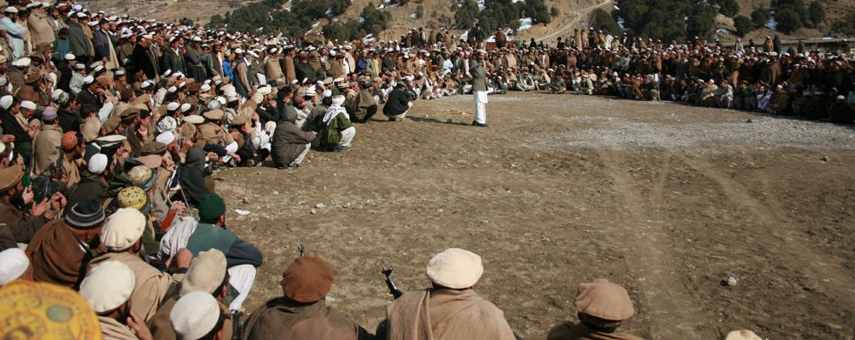Authors : Farooq Yousaf , Haroon Rasheed, Imtiaz Gul
Edited by: Zeeshan Salahuddin and Syeda Uruba Nisar
Executive Summary:
This report – part of the Center for Research and Security Studies (CRSS) special publications series – provides a brief introduction to the history, culture, traditions and demographics of the ethnic Pashtun tribes inhabiting the north-western border regions of Pakistan. The 27,220 square kilometre area inhabited by these tribes is historically known as the Federally Administered Tribal Areas (FATA), and, until May 2018, had been governed by the Frontier Crimes Regulations (FCR). Since then, Pakistan’s parliament has approved the merger of FATA into the Khyber Pakhtunkhwa province and they are no longer subject to governance informed by British colonial-era legacy.[1] The focus of this report is on the tribes, sub-tribes and notable families residing in the seven administrative units known as Agency (districts) that make up FATA. This report also looks at the traditions, cultural norms, and various traditional conflict mitigation and resolution mechanisms that these Pashtun tribes have practiced for centuries. An overview of economic, demographic, and geopolitical dimensions of FATA is also provided.
Furthermore, this report explores the string of counter-terror campaigns launched by the Pakistani military in FATA soon after the 9/11 terrorist attacks in the United States. It also highlights the many initiatives undertaken by the Pashtun tribes to counter the spiralling Al-Qaeda-inspired militancy. However, after the United States (US) led Operation Enduring Freedom in Afghanistan, these tribes were sandwiched between the military and the militants (both local Taliban and foreign – all likely inspired or affiliated with Al-Qaeda). These foreign militants turned out to be a boon for the local, cash-strapped economy; many tribesmen provided them refuge either out of ideological empathy, sympathy or for direct monetary gains. The most prominent among their paying guests were Arabs, Africans and Uzbek Al-Qaeda operatives. This confluence of political, social and monetary interests invariably drew the global attention on Pakistan with reference to FATA as the “terrorist haven” and the “most dangerous place” on earth for the presence of Al-Qaeda-linked militants.
What followed in the post December 2001 years has been a sad story of suffering of common FATA tribesmen due to the unusual militarization of the region. One also must note that the aftermath of the Global War on Terror (GWOT), the rise of the Taliban militancy and Al-Qaeda’s presence, there entailed debilitating socio-political consequences for the tribal society; suicide attacks even on traditional peaceful tribal assemblies tore the local tradition apart. Factional fighting and military operations eroded the authority of the Political Agent and of local influential aristocracy, particularly politicians and businessmen and descendants of spiritual families, once revered as the community elders. Many positive tribal values such as social safety, support networks and traditional tools of decision-making such as Jirga (the Pashtun assembly) have all suffered as a consequence. These traditional tribal structures remain under threat and increasingly vulnerable to interference both by the militants and the military. This may, however, change once these regions are constitutionally and administratively fully integrated into Pakistan.
The final part of this report explains the roles different stakeholders have played in the making of what we had in the name of FATA until May 29, 2018, when the President of Pakistan signed away FATA to herald the new, equal constitutional status for all the tribes inhabiting these regions. The new legislation – on the face of it – was of course a great news for the beleaguered tribes of FATA. The caretaker governments at the center and the provincial capital Peshawar, set up to oversee the elections in July, also moved with break-neck speed. On June 8, the Khyber Pakhtunkhwa government formally abolished the office of political agents and the collection of Agency Welfare Fund that became the root cause of exploitation and corruption in the erstwhile Federally Administered Tribal Areas.[2]
An official notification said the 116-year-old posts of political agents (PAs) in the seven tribal agencies were being re-designated as deputy commissioners, additional political agent as additional deputy commissioner and assistant political agent/assistant political officer as assistant commissioner. The nomenclature of seven tribal agencies and six frontier regions were also changed to tribal districts. Since the region will no longer remain under federal administration, the constitutional amendment bill also lead to a reduction in the number of seats in the National Assembly from 342 to 336. However, the members of the National Assembly to be elected from the region in the 2018 election were to continue till the end of the next assembly’s five-year term (until now FATA had 12 seats). Accordingly, the total seats in the Senate – the upper house of Parliament which gives equal representation to all federating units – also decreased from 104 to 96. The current eight FATA senators will continue to serve till the end of their constitutional term. Similarly, the (ex) FATA region will get 16 general and five reserved seats – four for women and one for non-Muslims – in the Khyber Pakhtunkhwa Assembly. The election on these seats is to be held within a year of the 2018 general elections. Once the process of merger has been finalised, total number of seats in the Khyber Pakhtunkhwa Assembly will increase from 126 to 147.
Yet, the road to full integration is bumpy and a little uncertain. Implementation on the ground – accompanied by corruption, pushback by some key stakeholders, lack of proactive policies and poor responses to urgent issues may stymie the process. This could, nevertheless, become relatively smoother if all key stakeholders adopted a whole-of-government approach for mainstreaming these neglected regions.
Please see the full PDF here.
___________________________________________________________________________

